
Features
Hot topics
Incident reports
Highrise horror
When Toronto Fire Services (TFS) was called to a severe, working fire at 17:02 on a bright, sunny September afternoon, we expected a fairly routine apartment fire. We didn’t expect the fire at 200 Wellesley St. E. to escalate to six alarms and we didn’t expect many of the challenges that met us in the community housing highrise.
November 25, 2010
By William Stewart
When Toronto Fire Services (TFS) was called to a severe, working fire at 17:02 on a bright, sunny September afternoon, we expected a fairly routine apartment fire. We didn’t expect the fire at 200 Wellesley St. E. to escalate to six alarms and we didn’t expect many of the challenges that met us in the community housing highrise.
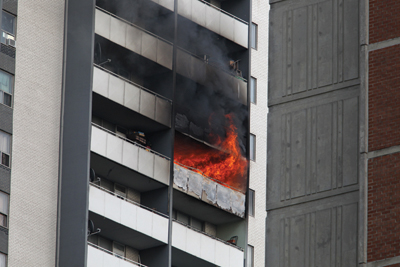 |
| High winds were a factor on Sept. 24 when Toronto firefighters were called to a fire in a 30-storey highrise in the city’s downtown core. Photo by John Hanley
|
Given the time of day, this challenging fire was not what would have been expected in any Canadian community. But the complexity of the fire and the time of day were in fact a benefit to TFS. Had this fire occurred in the early morning hours, there may have been a loss of life due to smoke migration among sleeping residents.
The Office of the Ontario Fire Marshal (OFM) was notified early in the Sept. 24 incident and attended to prepare for its role in the investigation. The OFM remained on scene for several days, determining the cause and origin of the fire that caused significant damage to the unit of origin and the fire floor. The investigation was completed on Oct. 1 but the cause and origin of the fire had not been released as of press time.
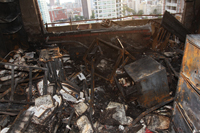 |
|
| Firefighters from Toronto Fire Services were unable to open the door of unit 2424 due to the heavy fire load inside. Photo courtesy Toronto Fire Services |
The magnitude of this incident was indeed very different from any normal highrise fire. The fire occurred on the 24th floor of the 30-storey complex, located in the inner core of the city. The initial crews responding to the first alarm proceeded to the 19th floor, as the enunciator panel indicated that the fire was on that floor. Smoke was visible on the west face of the building. The district chief requested a second alarm on arrival, and this fire would soon escalate to six alarms.
The first-in crew from Station 313 did not locate a fire on the 19th floor and continued to search the floors above the 19th floor. The fire was located in unit 2424. Fire attack commenced with a 38-millimetre hose line after adapting the standpipe. A heavy fire load and combustibles in the unit prevented the unit door from opening. The initial hose line was not effective on the fire due to the extreme heat and fire load encountered in the suite. TFS crews assigned to the fire floor for both fire attack and search and rescue faced an extremely hot, wind-driven fire. The crews then used a 65-millimetre line along with the 38-millimetre line as they tried to enter the apartment to extinguish the fire. Crew members were pushed back due to the high heat and fire load in the apartment. From the outset of the first arriving crews, the incident command system was established for the various crew assignments. Search and rescue, ventilation, lobby control, elevator control and accountability responsibilities were assigned by the incident commander. These responsibilities were upgraded to sector responsibilities as warranted by the incident. The fire chief, deputy fire chief and division commander arrived early in the incident. Responsibilities were assigned, the incident commander (in charge of operational fire fighting) would be the division commander, with the fire chief and deputy fire chief responsible for establishing a unified command and focusing on all non-firefighting activities, while acting in a consulting role with the incident commander.
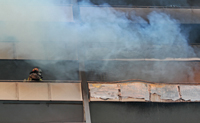 |
|
| Many of the complex’s 1,200 residents were able to evacuate the building within the first few minutes of the fire, but smoke in the stairwells prevented those on the upper floors from evacuating immediately. Search and rescue crews on every floor aided residents in finding shelter in place and on the balconies. Photo by John Riddell |
Weather played a significant role in this incident, as the daytime temperature reading was 30 C, with winds from 40 to 60 kilometres per hour and gusts of up to 70 kilometres per hour. The immediate impact was a wind-driven fire due to the heavy fire load on the west-facing balcony of the 24th floor and the rapid extension to the apartment. Crews were faced with an extreme fire load contained in the one-bedroom apartment. I had never witnessed an apartment fire that required firefighting operations over a prolonged period of eight hours. The fire was brought under control by the use of 65-millimetre hand lines and the establishment of a ground monitor into the unit. Besides bringing the fire under control, the incident commander also faced the challenge of co-ordinating task assignments to crews to deal with reported emergent incidents in more than 40 additional apartments. He also had to liaise with the resource sector to ensure all resources were maintained for the duration of the incident. Roles within the command vehicle were assigned to co-ordinate these tasks in parallel with the firefighting and rescue operations.
The fire forced the evacuation of 1,200 residents from the address. The housing complex, which consists of two 30-storey towers containing 712 apartment units, is one of the largest public housing properties in Canada under the ownership of the Toronto Community Housing Corporation. Shelter Housing and Support for the City of Toronto, along with various agencies, provided accommodations for the residents in the local community centre across the street from the fire incident. Residents were briefed and moved to various sites across the city.
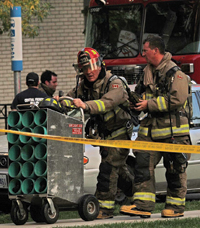 |
|
| Heat – the temperature was 30 C on Sept. 24 – and the duration of the incident stressed Toronto Fire Services crews. Photo by John Riddell |
Many residents of the complex chose to evacuate the building in the first few minutes of the fire. However, many could not evacuate the upper floors of the apartment building due to smoke migration in the stairwells. Fire crews were assigned to search and rescue, and conducted primary and secondary searches of the complex. More than 200 doors had to be forcibly opened because the tenants had changed the locks. Ventilation crews used vertical ventilation to the stairwell shafts. During the course of firefighting operations, the building’s EVAC system was used to direct tenants to shelter in place and to seek refuge on the balconies. Tenants were also instructed to call 911 should they encounter any difficulties because of the fire. Fire crews were assigned to calls for assistance to ensure tenant safety or to evacuate as required. Elevator and lobby control was established early in the incident to aid in moving crews in and out of the building.
Toronto Emergency Medical Services and Toronto Police Service were on scene performing their assigned duties, from medical protocols to perimeter and security details. A total of 17 patients – 14 residents and three firefighters – were transported to Toronto-area hospitals and later released. The regular daytime temperature combined with high heat from the fire impacted the fire crews operating on the fire floor and upper floors. Crews were rotated along with re-hydration on the exterior of the building. Paramedics monitored TFS members as crews went through rehab prior to reassignment. TFS was fortunate to have a number of crews rotate through this incident without serious injuries.
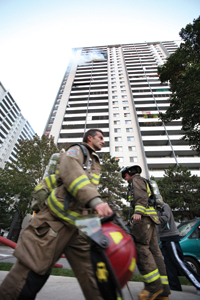 |
|
| The standard 38-millimetre hose line was not sufficient to deal with the fire load in the Toronto apartment building. The use of 65-millimetre hose lines for fire attack was required for both hand lines and the establishment of the ground monitor to control the fire. Photo by John Hanley |
The fire was contained to the 24th floor, but there were a number of balcony spot fires caused by flying embers that were extinguished by TFS crews. There was significant smoke and water damage to the north complex and extensive fire damage to the unit of origin and fire extension to the corridor of the 24th floor. The upper floors suffered heavy smoke damage.
On the morning of Saturday, Sept. 25, TFS fire prevention staff and staff from the Toronto Community Housing Corporation (TCHC) arrived on scene and commenced checking the units. Each unit was checked to ensure a working smoke alarm was installed and operational. TFS fire prevention staff remained on scene until Oct. 1, helping TCHC staff deal with any apartments that had high combustible fire loads. A number of units were identified and TCHC staff took appropriate actions to ensure the fire load issues were resolved in each unit. Fire prevention staff inspected every door to ensure that doors would be replaced in more than 200 units. An extensive fire watch was developed for the 30 floors of the complex that will remain in place until the fire panel is replaced. The TFS fire prevention division chief attended three community meetings with the occupants to discuss details of the inspection of the building and ensure that residents would recognize the measures were taking place to ensure their safety.
The residents were assured that fire prevention staff and TCHC would meet and join together regularly to bring the important message of fire safety to residents and staff at this facility.
Lessons learned from this fire are significant, given the high combustible fuel load in the unit of origin:
- The standard 38-millimetre hose line was not sufficient to deal with the fire load in the suite.
- The use of 65-millimetre hose lines for fire attack was required for both hand lines and the establishment of the ground monitor to control the fire.
- The early establishment of a unified command with Toronto Fire Services as lead proved to be invaluable. It facilitated a process early in the incident that demanded business cycle meetings to occur every 60 minutes for the first 12 hours of the incident. This process continued for three days with the meeting intervals increasing as time permitted. Many agencies, including Toronto Fire Services, Toronto Police Services, Toronto Emergency Medical Services, Toronto Hydro, the City of Toronto’s Shelter, Support and Housing Administration, Toronto Community Housing Corporation, the Ministry of the Environment, and the Toronto Public Health were aware of the unified command approach and knew where to go to share information and raise questions. Toronto fire prevention staff remained on site for four additional days, led the business cycle meeting and released the building to TCHC on Oct. 1 after fire safety measures and inspections were completed.
- A key element was the integration of fire prevention into the incident command structure to ensure that the building owner carried through with all the measures required in a timely fashion so residents could re-enter their units.
Note: See related items on pages 16 (Trainer’s Corner) and 38 (FlashPoint).
Chief William Stewart is a 38-year fire service veteran, having served in the former City of North York Fire Department for 26 years prior to the amalgamation of the new City of Toronto on Jan. 1, 1998. He has served as an operations firefighter, captain, administration chief, assistant deputy, deputy chief and has been fire chief since May 1, 2003. Chief Stewart has served on numerous committees and boards. He is a graduate of the Ontario Fire College, the executive development program and the Canadian Emergency Preparedness College and has a certificate in public administration and governance from Ryerson University and an honorary bachelor of applied studies from Humber College. He is committed to lifelong learning, and is currently serving as a board member for public administration and governance at Ryerson.
Print this page